
Change management exercises help change employee attitudes toward organizational transformation with activities designed to facilitate the transition from old to new processes, systems, or strategies.
These engaging exercises help promote change objectives among employees and teams, ease any resistance to change, and provide opportunities to iron out any concerns or inquiries regarding the change.
A Change Synergy survey shows that only 31% of respondents reported that their organization prevents employees from being overloaded by change demands.
By facilitating collaboration, communication, and problem-solving, change management exercises can mitigate the potential for organizational conflict and encourage individuals and teams to embrace change wholeheartedly.
These activities create an atmosphere of exploration and discovery, where participants can understand the organization’s vision and drive genuine transformations.
This has become increasingly important as research shows that 79.7% of individuals must regularly adapt their business strategies every two to five years.
In this article, we’ll further define what change management exercises are before sharing nine change management exercises that are so important.
For quick reference, these are:
- Cross your arms
- The alien at dinner
- The RACI Matrix
- Changing places
- The ups and downs of change
- The Four P’s
- Fishbowl Discussion
- Bouncing back
- Can do company
To conclude, we’ll emphasize the reasons for employee resistance and guide you on sustaining the momentum after the games end.
These exercises are straightforward, yet they can make a significant impact.
What are change management exercises?
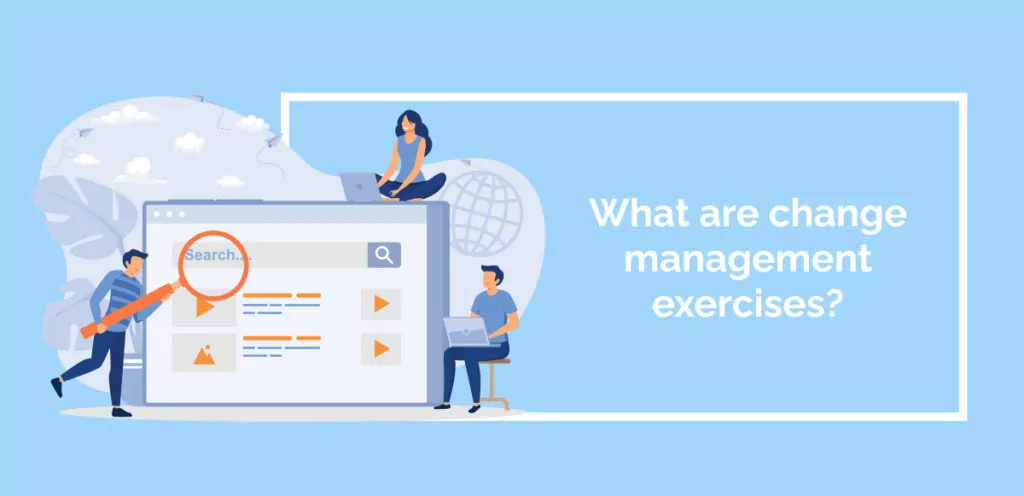
Change management exercises are interactive activities that help shift employees’ attitudes toward organizational transformation.
These exercises aim to cultivate a proactive and agile workplace culture by engaging employees in team-building activities, problem-solving simulations, role-playing scenarios, and other engaging methods.
By addressing resistance through games and activities, you can improve your change management strategy. These change management activities encourage employees to self-reflect on their approach to organizational change.
You might think playing games in the workplace is counter-productive, but the opposite is true.
The change management process can tax workers, requiring them to step out of their comfort zones, learn new skills, and adjust to unfamiliar roles and responsibilities.
Additionally, the emotional and psychological impact of change, such as fear of the unknown or resistance to letting go of familiar ways, can further contribute to the demanding nature of the process.
9 Change management exercises to lower employee resistance
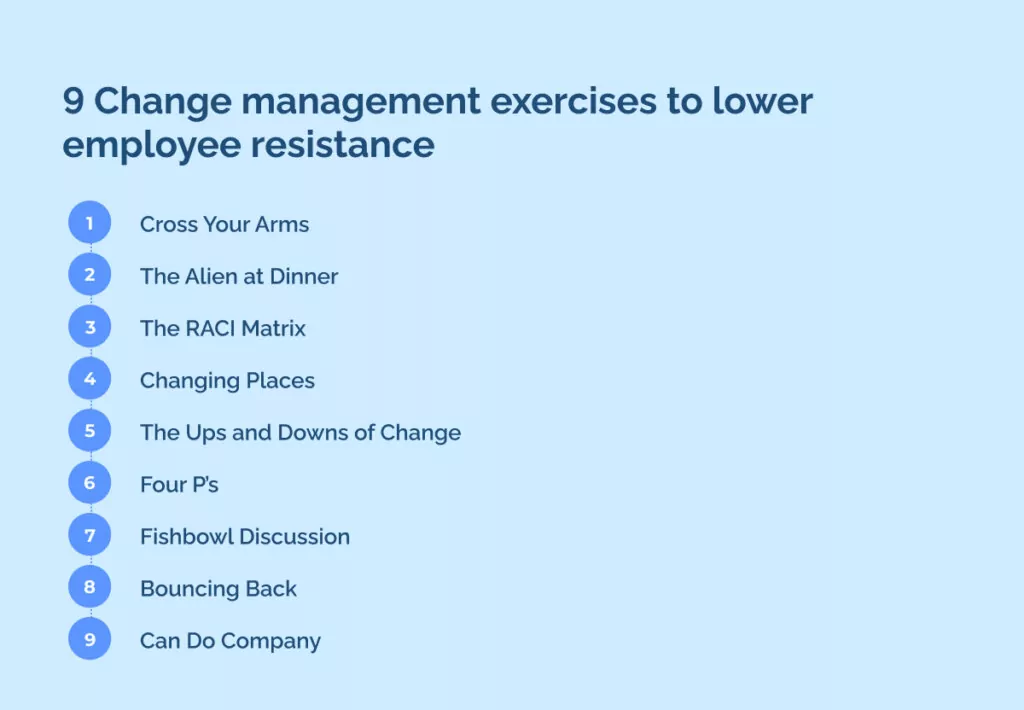
The following are nine change management exercises to help you prepare and implement organizational changes.
These exercises can be used individually or in combination with each other:
1. Cross Your Arms
How to play:
During a team-building exercise, instruct employees to cross their arms and then ask them to try crossing their arms the opposite way once they feel at ease.
This simple activity aims to promote self-awareness and highlight the importance of embracing discomfort for personal growth.
Afterward, engage in a thoughtful discussion about the possible discomfort they might have experienced during the second attempt despite it being the same action.
Encourage them to reflect on the significance of stepping out of their comfort zones and the potential for transformation that lies within.
What’s the point?
This engaging activity effectively steers the conversation toward specific changes within your organization.
Examining the various positions where one can cross their arms and highlighting the inherent difficulty serve as a powerful metaphor for any transformative process’s challenges.
Benefits:
Employees can get used to the idea of change being uncomfortable at first. Soon, they realize that the new way of doing things becomes comfortable over time. This teaches resilience and prevents employees from giving up too quickly.
2. The Alien at Dinner
How to play:
Ask employees to imagine themselves as aliens from a distant planet, observing a peculiar human dinner party.
As they observe, their task is to keenly identify and explain the unusual social norms practiced by humans.
For instance, they may question why humans willingly consume poisonous alcohol or why they engage in the tradition of clinking their glasses together when celebrating.
By delving deeper into these peculiarities, the employees can gain a unique perspective on human behavior and foster a greater understanding of our complex social customs.
What’s the point?
Encourage your employees to be more open-minded toward changing long-standing methods.
Similar to how aliens see human customs as strange, this activity gives individuals a different view of their organization.
It highlights alternative ways of doing something and helps employees shake off traditional thinking that might be stalling their progress.
Benefits:
This game works to transform mindsets about traditional ways of working. It helps employees detach from old processes and adopt new ones with minimal disruption. When introducing a new work process, you can remind employees of the lessons of this game.
3. The RACI Matrix
How to play:
You can introduce the RACI (Responsible, Accountable, Consulted, Informed) matrix during a team meeting or workshop. This game helps clarify everyone’s roles and responsibilities in a project or process.
Divide employees into small groups and assign them a specific project or task. Ask each group to create their own RACI matrix for the given project, identifying who is Responsible, Accountable, Consulted, and Informed for each task or decision.
Afterward, bring the groups together to discuss and compare their matrices. Encourage them to discuss discrepancies or differences in their approaches and facilitate a conversation on how these differences can be resolved.
Think of it as a way to assign tasks and keep everyone in the loop. You can use examples and scenarios to make it more relatable and show how it all comes together.
What’s the point?
The RACI matrix is a powerful tool for clarifying roles and responsibilities within a team or organization. This exercise helps employees understand the importance of clear communication and accountability in managing change.
By actively participating in creating their own RACI matrix, employees gain a better understanding of their roles and how they contribute to the overall success of a project or process.
Benefits:
The exercise helps reduce confusion by clearly defining roles and responsibilities, leading to greater employee accountability. It also fosters better communication within the team as they discuss and compare different matrices. Moreover, the RACI matrix is a great tool for managing change, keeping all stakeholders engaged and well-informed throughout the process.
4. Changing Places
How to play:
Start by promoting a sense of autonomy among employees, encouraging them to select their workplace seats freely.
After some time, ask them to switch to a different seat and take a moment to reflect on how their perspective has shifted and the reasons behind it. To provide a physical break, incorporate a brief stretching session to refresh both body and mind.
Once the stretching is complete, allow employees to choose their seats again and keenly observe which seats they naturally gravitate towards. This observation can provide valuable insights into their preferences and tendencies.
To deepen the exploration, repeat the game a second time and carefully observe if individuals behave in the same manner. Encourage open discussion and explore the reasons behind any changes in their seat choices. This discussion can shed light on the various factors that influence decision-making and highlight the importance of context.
By adding these additional details and opportunities for reflection, this exercise can offer a more comprehensive understanding of how workplace dynamics and individual perspectives can evolve over time.
What’s the point?
The objective of this game is to steer the conversation toward our natural resistance to change and the advantages of stepping out of our comfort zones into uncharted territory. This is a chance to recognize the fear of the unknown and provide insights into the necessity of forthcoming changes.
Benefits:
Getting your employees out of their comfort zone is crucial to a successful change project.
Too often, employees resort to old habits because it’s easier. This activity demonstrates the advantage of taking a new perspective on your environment. Physical management exercises like this have a bigger impact on employee mindsets because they stick with them longer.
5. The Ups and Downs of Change
How to play:
Ask employees to stand in a horizontal line, facing outwards.
Before starting the game, write down a list of terms related to change management—for example, training, digital transformation, digital adoption platform, business process, etc.
Read out each word on your list. Employees must either take a step forward if they feel positive about the term or a step backward if they feel negative.
After completing your list, notice the positions of everyone in the room.
What’s the point?
Employees can self-reflect on their approach to change management terms by visualizing their reactions to change. The pattern of employees around the room demonstrates the need for more cohesion in the workforce during change.
Benefits:
This activity shows the detrimental effect of an individual’s resistance to change.
By seeing how different workers react to change, the team can collaborate more easily to find a way forward. Use the opportunity to discuss the importance of sticking together as a team during times of change.
6. Four P’s
How to play:
Start this exercise with a large whiteboard or flip chart. Create four columns and label them left to right: Project, Purpose, Particulars, and People.
Then, have your group of employees fill in each column as follows:
- Project — list the upcoming changes.
- Purpose — ask what benefits the change will bring. Will it increase revenue? Will it make processes more efficient?
- Particulars — list the details of what needs to change.
- People — have the group identify which employees will need to change how they do things or participate in the change.
What’s the point?
This exercise will help participants connect the four areas and see the greater purpose of the change they will soon experience. Participants conclude that if they don’t change how they do their job, they won’t achieve their objectives.
Benefits:
The takeaway from this activity is that change management is a multi-step process. Employees are more likely to engage with change if they understand the change management process.
7. Fishbowl Discussion
How to play:
Arrange chairs in two concentric circles – inner and outer circles. Select a few participants to sit in the inner circle while the remaining participants sit in the outer ring.
Pose a change-related question or topic to the participants in the inner circle. They will discuss sharing their thoughts, perspectives, and experiences regarding the change.
Meanwhile, the participants in the outer circle silently observe the discussion. After a predetermined time, rotate the inner circle participants with outer circle participants, allowing new voices and perspectives to participate in the discussion.
Repeat the process with different questions or topics, ensuring everyone can participate in both the inner and outer circles.
What’s the point?
The fishbowl discussion creates a safe space for employees to share their thoughts and experiences regarding a change openly.
It encourages dialogue, active listening, and empathy among participants. By hearing diverse perspectives, employees gain a deeper understanding of the impact of the change and can identify common challenges or opportunities.
Benefits:
The fishbowl discussion encourages participants to express their thoughts and concerns, facilitating open communication.
Hearing different perspectives helps participants develop empathy toward others’ experiences and gain a broader understanding of the change. This allows participants to feel heard, supported, and connected with their colleagues, creating a stronger sense of teamwork during times of change.
8. Bouncing Back
How to play:
Gather all the employees in a spacious and brightly lit area and hand out colorful bouncy balls to pairs of colleagues. Encourage them to stand a few feet apart and engage in a playful exchange, bouncing the balls back and forth for a few minutes.
Afterward, as the laughter and energy subside, ask the participants if they have ever doubted whether the ball would fail to bounce back up. Take a moment to acknowledge that, just like the resilient bouncy balls, they, too, can bounce back from challenges that come their way. Remind them that setbacks are merely temporary, and with determination and resilience, they can overcome any obstacle.
Allow employees to keep their bouncy ball as a tangible reminder of their ability to bounce back and embrace new opportunities. This small token can serve as a visual cue, reminding them of their inner strength and resilience in the face of adversity.
Embrace the spirit of bouncing back, and let the bouncy balls symbolize the unwavering determination and resilience that define your team.
What’s the point?
The game itself is simple. But don’t forget, the memento of the ball is the real point of this game. The ball represents an employee’s capacity for resilience. This game acts as a reminder they can overcome any challenge.
Benefits:
This activity teaches determination by addressing employees’ fear of failure.
Most employees resist change because they aren’t sure it’ll pay off. As a change manager, your role is to communicate the benefits of change. This activity helps to remind employees that they can bounce back after failing.
This change management exercise reduces fear of failure and encourages employees to take more risks.
9. Can Do Company
How to play:
For this final change management exercise, divide employees into groups. Have them develop an idea for a company, such as candy bars for cats or water bottles for dogs.
Assign members of each group-specific job functions like designing, marketing, distributing, etc. Have each “mini-company” prepare a product and business plan presentation.
After 10 minutes, change the group dynamic by moving participants from one group to another. Change the specifications for the final presentation and share important information with only one group member.
Depending on your time, you can repeat the changes or spread them throughout. After the allotted time, each group can present and pick a winner.
What’s the point?
This exercise will push participants to be flexible, communicate, and work together.
After the activity, follow up with an open discussion on how teams adapted to changes. What benefits came from their new members or new specifications? Employees can reflect on how they collaborate with different teams and reflect on what works and what doesn’t.
Benefits:
This game shows employees how quickly they adapt to changes when needed.
Jumping into a new work dynamic can be daunting, but practice helps. When faced with a change in the future, employees can remember this activity and how they thrived in unfamiliar environments.
Why Are Change Management Exercises Important?
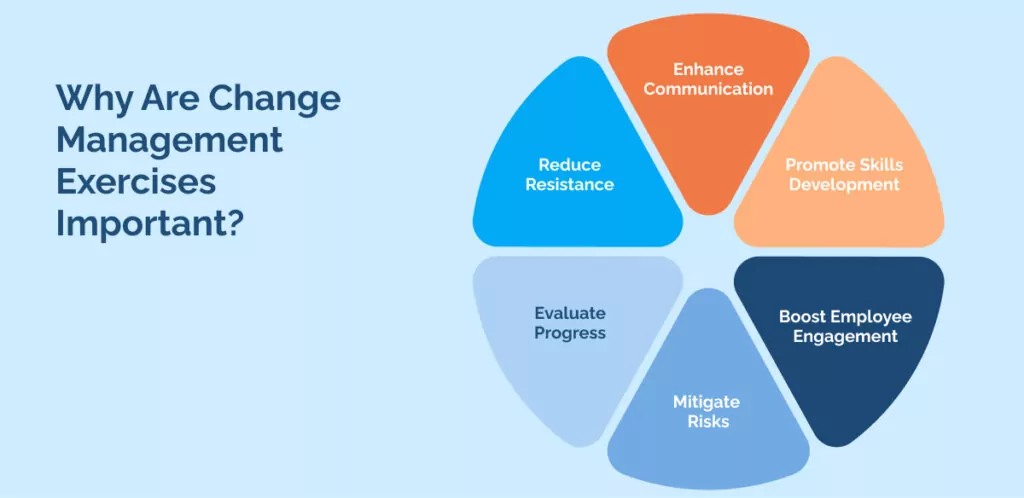
Change management exercises play a pivotal role in successfully implementing changes within an organization.
Here are some reasons why they are important:
Reduce Resistance: Exercises help employees understand and accept changes, reducing resistance and fostering a positive attitude towards the change.
Enhance Communication: They act as an effective communication tool, ensuring all employees understand the reasons for the change and their roles in implementing it.
Promote Skills Development: These exercises can help employees develop the skills needed to adapt to new systems or processes.
Boost Employee Engagement: These exercises can increase employee engagement and commitment by involving employees in the change process.
Mitigate Risks: They allow potential issues to be identified and addressed before the change is implemented, reducing the risk of failure.
Evaluate Progress: Change management exercises provide a platform to assess the progress of the change initiative and make necessary adjustments.
How do change management exercises help lower employee resistance?
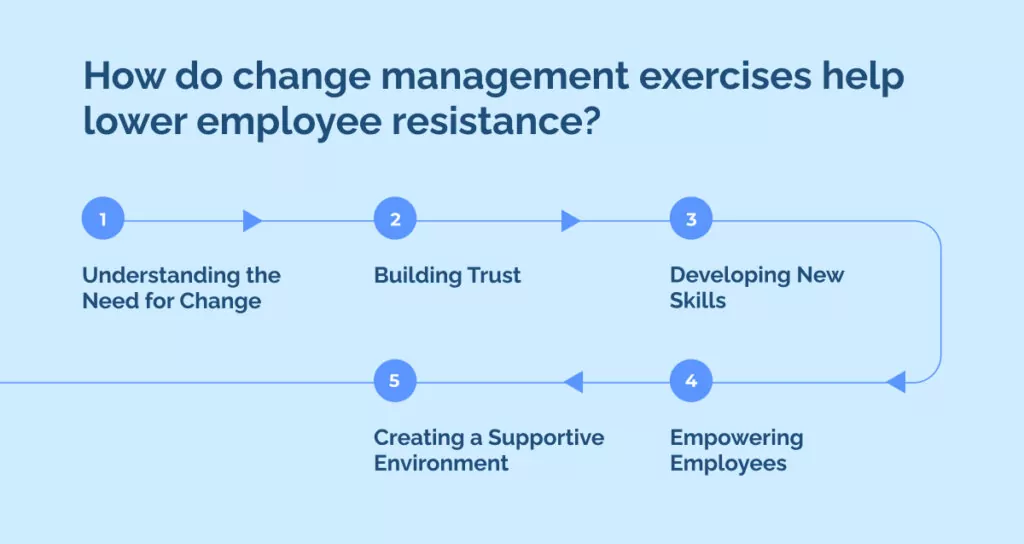
Change management exercises are crucial in helping employees navigate the uncertainties of organizational change.
Rather than fostering resistance, they help mitigate it.
Here’s how:
- Understanding the Need for Change: These exercises explain why the change is necessary for the organization’s growth. When employees understand the ‘why,’ they are more likely to support the change rather than resist it.
- Building Trust: Change often breeds fear and uncertainty. However, transparent communication during these exercises builds trust between the leadership and the employees, reducing anxiety and resistance.
- Developing New Skills: Change management exercises often include training employees with the skills needed to adapt to new systems or processes. This increases their confidence and reduces their inclination to resist change.
- Empowering Employees: These exercises give employees a voice and an opportunity to contribute ideas. This makes them feel valued and involved, reducing feelings of alienation that often lead to resistance.
- Creating a Supportive Environment: Change can be difficult, but a well-planned exercise ensures a supportive environment where employees can express their concerns and receive the help they need. This fosters a positive attitude towards the change, mitigating resistance.
Businesses That Have Used Change Management Exercises To Lower Employee Resistance
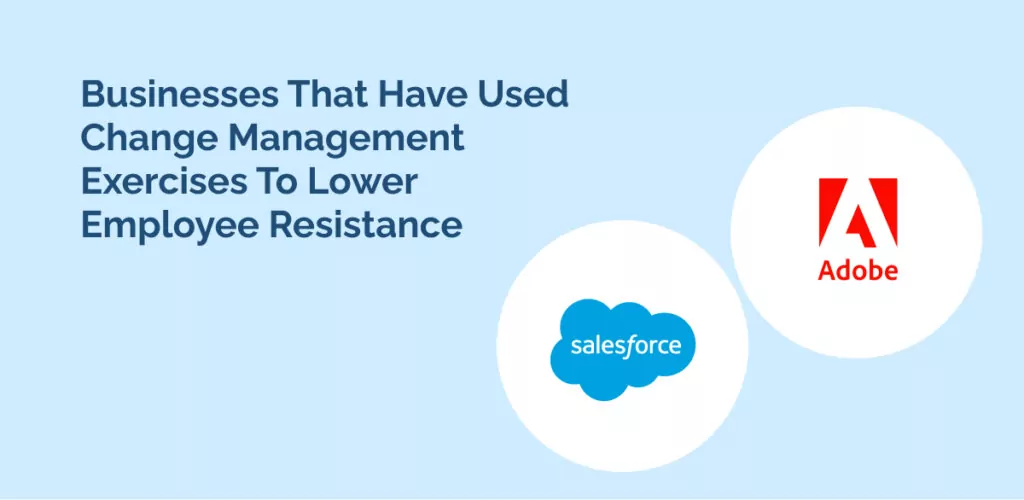
It’s the businesses that know how to adapt quickly who survive.
Think about the companies that are no longer around, like Blockbuster or Kodak. Did they fail to innovate and change with the times? Absolutely.
In this section, we’ll discuss how businesses have used change management exercises to lower employee resistance and successfully implement changes in their organizations.
We’ve found two successful examples for you to learn from:
Salesforce
Salesforce, a leading CRM provider, recently introduced an AI feature, “Einstein“. Recognizing the need for effective change management, Salesforce developed a robust strategy to ensure users could adapt and leverage this new tool.
The company provided detailed documentation and webinars to explain Einstein’s functionalities. They also conducted training sessions for hands-on experience.
Most notably, Salesforce used “Trailhead,” their gamified learning platform, to guide users through the changes. This interactive approach helped users understand Einstein’s benefits and reduced resistance to its implementation.
Salesforce’s comprehensive strategy ensured a smooth transition to Einstein, showcasing their commitment to user experience during periods of significant technological advancement.
Adobe
The transition by Adobe, a leading software company, from selling packaged software to a cloud-based subscription model marked a significant turning point. This new approach necessitated adjusting both working and selling practices among employees.
To navigate this shift, Adobe put into effect a robust change management strategy. Central to this was transparent communication about the reasons for the move and the subsequent benefits it would offer. This open dialogue helped allay concerns and ensured employees were aligned with the company’s strategic objectives.
Adobe also invested heavily in training, preparing its workforce with the skills necessary to operate within the new business model. This proactive step was crucial in ensuring that the change was not only accepted but also effectively implemented by the staff.
Further support came in the form of a dedicated “Change Management Office tasked with overseeing the transition process and providing ongoing support, thus reducing employee resistance and smoothing the path toward the new operational model.
Keep your Team Focused with Fun
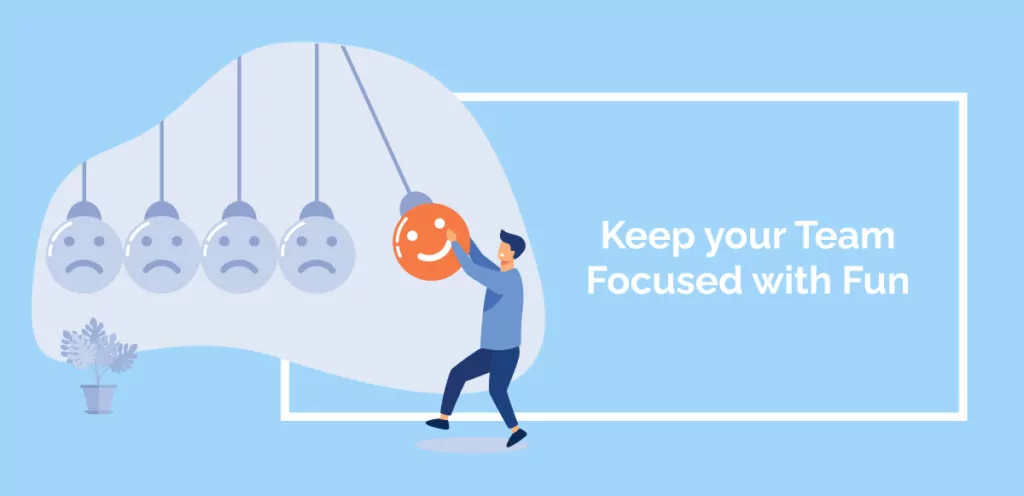
Enterprise-wide change initiatives demand a lot from their employees.
Even smaller-scale change management impacts the workforce. The learning process can be daunting, but your initiative will fall apart if you don’t make change fun.
Change management exercises like the ones we’ve listed above can add variety to the training process.
Practical change management exercises encourage workers to collaborate, and collaboration is crucial to achieving your business outcomes.
Remember, successful change management is all about supporting staff during change.
Change can be tedious and uninspiring for lower-level employees. Unlike executives, they don’t see the company-wide benefits of transformation. That’s why change management activities are such essential change management tools.
Address the anxiety of your employees by focusing on their needs and asking them to be honest about their concerns.
Not only will these change management exercises engage employees in learning new processes, but they’ll also encourage engagement in future change projects.
WalkMe Team
WalkMe spearheaded the Digital Adoption Platform (DAP) for associations to use the maximum capacity of their advanced resources. Utilizing man-made consciousness, AI, and context-oriented direction, WalkMe adds a powerful UI layer to raise the computerized proficiency, everything being equal.



